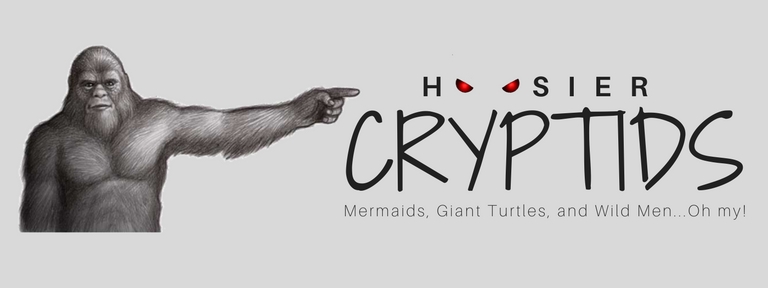 EDITOR’S NOTE: While the Indiana Historical Bureau does not research folklore and cryptozoology, in the course of doing historical research in newspapers about other topics, we sometimes come across odd stories like we have collected here. We thought some people would find these strange accounts from historical records interesting.
EDITOR’S NOTE: While the Indiana Historical Bureau does not research folklore and cryptozoology, in the course of doing historical research in newspapers about other topics, we sometimes come across odd stories like we have collected here. We thought some people would find these strange accounts from historical records interesting.
A cryptid is defined as “An animal whose existence or survival is disputed or unsubstantiated.” The most famous cryptids include Scotland’s Loch Ness Monster, the Pacific Northwest’s Bigfoot, and the Chupacabra of Central and North America. These mysterious animals tend to inhabit mysterious places; deep, dark lakes, impenetrable forests, and wide open desserts. It’s a bit surprising, then, that there is such a long and rich history of Hoosier cryptids. From Ohio River “mud mermaids” in southern Indiana to a Michigan City “wild child” up north, historic newspapers are riddled with reports of unexplained (and mostly unconfirmed) creatures in the wilds of Indiana.
Some of the most commonly reported sightings fall into the category of humanoid creatures. The most widely known of these is Bigfoot and while they’re most often associated with the Pacific Northwest, there have been some sightings here in the Hoosier State. Stories of Bigfoot have their roots in the legends of Native Americans and predate the arrival of Europeans to the continent. These stories existed long before there was one single term to describe all large, hairy, humanoid creatures, making it difficult to suss out reports of early sightings in newspapers. Reports of “wild men,” are probably the predecessors to modern Bigfoot sightings. Here, we will examine four of these reports which span over a century.
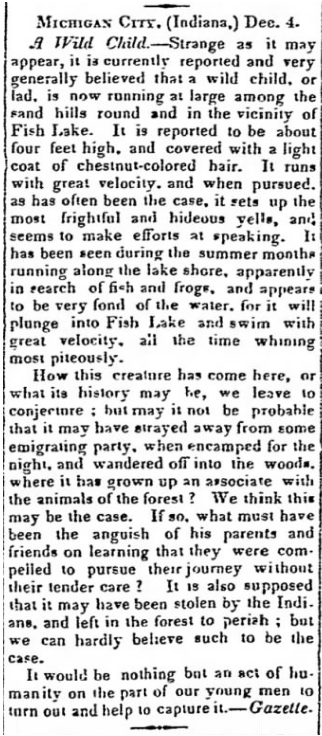
In late 1839, a Pennsylvania newspaper picked up the story of a “Wild Child” sighting in Michigan City, Indiana. About four feet tall and covered in light brown hair, the child apparently was a very fast runner and swimmer and very fond of water. The report theorizes that the “creature” may have been the child of immigrants who wandered too far from camp and, left to his own devices, grew wild and (apparently) very hairy. The report concludes by declaring “It would be nothing but an act of Humanity on the part of our young men to turn out and help to capture it.”
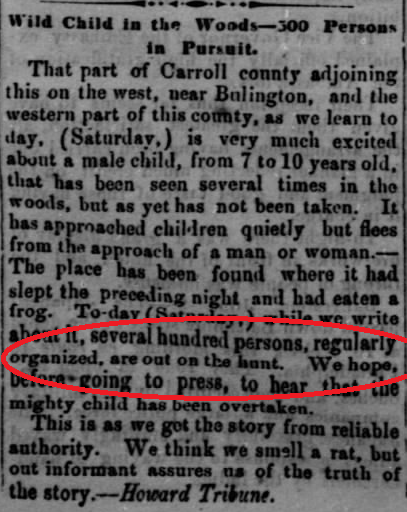
Twenty-one years later, in 1860, the young men of Carroll County had
turned out to help capture another “Wild Child.” This article from The Weekly Republican in Plymouth, Indiana reports that a search party of 300 has formed to help look for a male child between the ages of 7 and 10 who had been sighted several times. Since this is the only account of the sightings found in newspapers and there are no reports indicating that this child had an unusual amount of hair, it’s quite possible that this was nothing but a lost child rather than a small Bigfoot. Even the newspaper expresses doubts, saying “we think we smell a rat.”

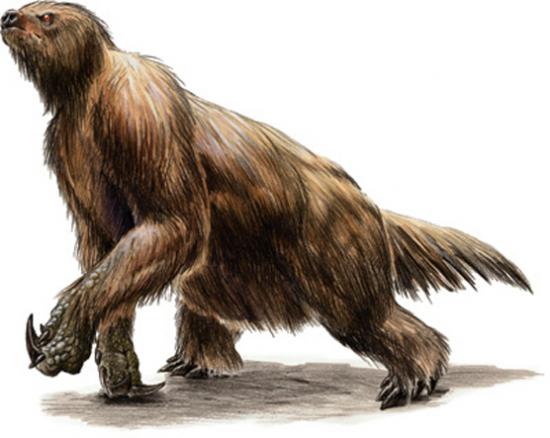
In 1937, an animal alternately described as a “monster hairy ape,” a “giant sloth,” a “cross between an ape and a sloth,” and simply a “monster” was reported in Boonville, Indiana. In some articles, the beast was described as harmless but in one article, it was said that the beast “mauled a police dog so bad it had to be shot.” Community members banded together to search for the beast, mothers kept their children inside, and traps with raw meat in them were laid with hopes of luring the creature in. All was for naught as on August 19 newspapers announced that the search was being “temporarily abandoned” and no mentions of resuming search was found in the following months. One article, written about a month later, points out that the rumors began to spread just as blackberry season started and suggests that “Boonville folk” spread the tale to keep people away from their blackberry patches.
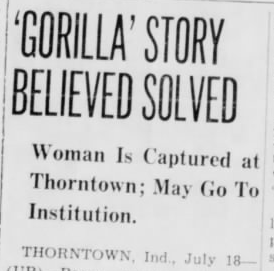
Twelve years later, there was a rash of sightings of a large, hairy, humanoid animal around Thorntown, in Boone County. The papers
reported nearly 30 and claim the town was so terrorized that residents weren’t venturing out at night. An article ran on June 22, 1949 in the Lafayette Journal and Courier reporting that the “Thorntown Gorilla,” as it was being called, was nothing more than a hoax planned by members of the Sportsmen and Wild Life club. The mystery apparently persisted because on July 17, the Richmond Palladium headline read “Safari Seeks ‘gorilla’ at Thorntown.” This “safari” consisted of four posses, including State Conservation officers and nearly 30 Thorntown residents. What they found wasn’t a gorilla. Nor was it a hoax. What they found was much more tragic; a woman described as “deranged” and “mentally ill.”
Big Foot-like creatures aren’t the only kind of humanoids in the cryptozoology field. Mermaids also fit into the subdivision. It may seem unlikely for a land locked state like Indiana to have produced mermaid stories, but in late 1894 Ohio newspapers reported that a pair of “mud mermaids” had taken up residence on a sand bar in the Ohio River near Vevay, Indiana. The Cincinnati Enquirer gave a very detailed description of the rather monstrous sounding creature:
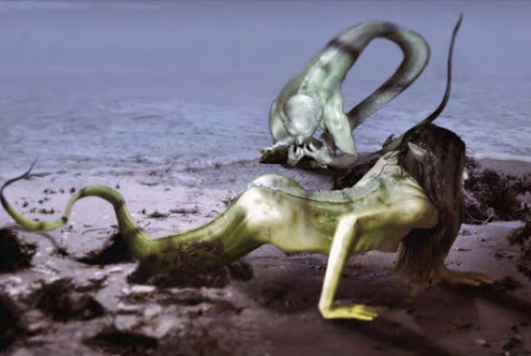
“The beast is about five feet in length…Its (sic) general color is yellowish. The body between the four legs resembles that of a human being. Back of the hind legs it tapers to a point…The extremities resemble hands and are webbed and furnished with sharp claws…it is devoid of hair…Its (sic) ears are sharp-pointed and stand up like those of a dog…”
While newspapers report that sightings of the duo had started four year earlier, no newspaper reports can be found recounting earlier sightings and the mermaid craze ends as quickly as it began, with the first report in September and the last just under two months later in November.

Of course, humanoid creatures aren’t the only kind of cryptid that has been reported to dwell in Indiana. Eye witness reports of a lake monster have been coming out of Lake Manitou, near present day Rochester, for many years. In an 1838 article, the Logansport Telegraph described a “well known tradition of the Indians respecting the Monster in the ‘Devil’s Lake.'” Witnesses estimated the monster “measured sixty feet” and described the Lake Manitou monster as having a head about three feet across with the contour of a cow’s head, a tapering neck, and being “dingy” colored with large bright yellow spots. Below is a depiction of the terror of Manitou Lake, published August 11, 1838 in the Logansport Telegraph.
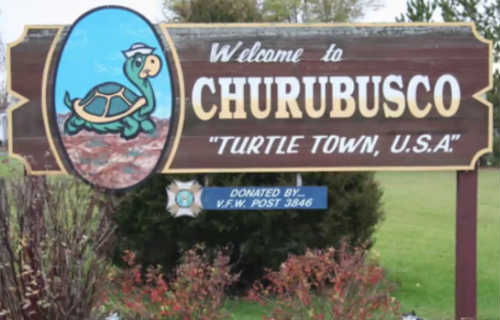
Perhaps the most famous Indiana cryptid, definitely the one most thoroughly covered by newspapers, is a giant turtle called the “Beast of Busco” which was reported to live in a 10 acre lake near Churubusco, Indiana. Also called Oscar, the turtle’s shell was said to be as big around as a dining room table. Gale Harris, the owner of the lake Oscar called home, first saw the beast a year after purchasing the farmland the lake sat on, 1948. In early March 1949 the Columbia City Commercial Mail demanded a hunt for the reptile, running headlines like “Five Hundred Pound Turtle Would Make Lots of Good Turtle Soup.” The residents of the small town turned into turtle hunters; they proposed building a turtle house in the middle of town to display him in if they caught him. They tried everything to get the turtle out of the lake including using a crane, bringing in divers, draining most of the water from the lake, and using a female turtle to lure it out. They even offered a $1,800 reward for the capture of the beast, all to no avail. Eventually, it was concluded that the Beast of Busco either never existed or escaped to another lake. Dubbed “Turtle Town USA,” Churubusco still celebrates its famous reptilian resident with the annual Churubusco Turtle Days festival.
These are just a few of the many unexplainable creatures that have been sighted in Indiana. So, the next time you’re hiking in the woods or swimming in the Ohio River, keep your eyes open. You never know what you might find.
